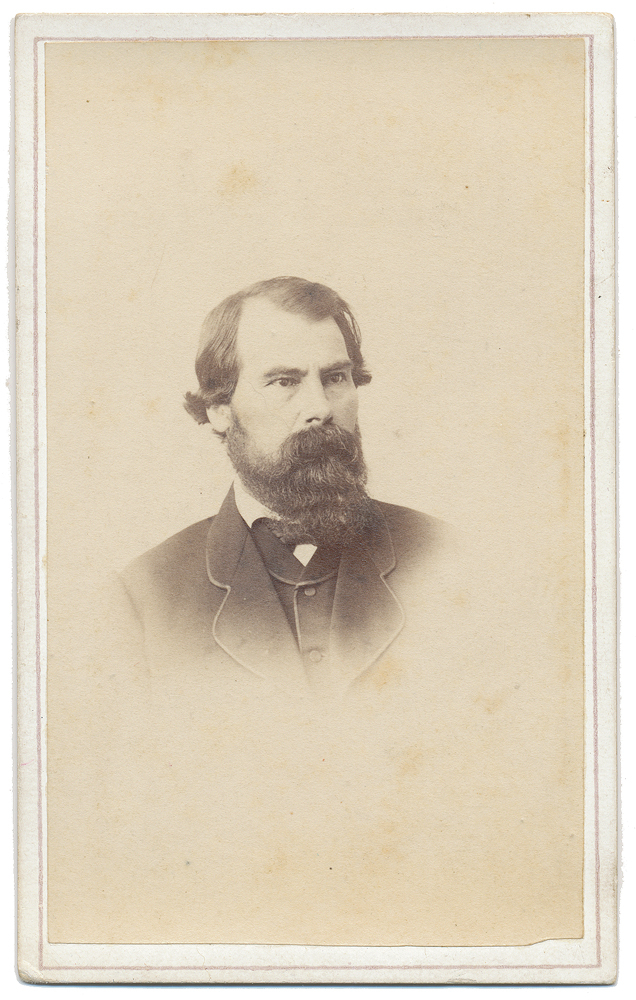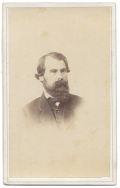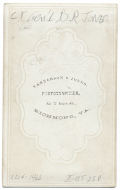site search
online catalog
POSTMASTER GENERAL OF THE CONFEDERACY JOHN H. REAGAN – RICHMOND PHOTOGRAPHER

$550.00 SOLD
Quantity Available: None
Item Code: 1138-253
Bust view CDV of John H. Reagan in a dark civilian suit.
Contrast and clarity are excellent. Paper and mount are good.
Reverse has a photographer’s imprint for VANNERSON & JONES… RICHMOND, VA. Top of reverse has an erroneous modern pencil ID of “GEN’L D. R. JONES.”
Image is from the collection of the late William A. Turner.
John Henninger Reagan was born in Sevier County, Tennessee on October 8, 1818. He received his early education at Nancy Academy in Sevierville, at Boyd's Creek Academy, and Maysville Seminary. To support his education, he took various positions as a hired-out farmhand, a salesman, a bookkeeper, and an overseer. Once he completed his education, he pursued positions in Decatur, Alabama, Tuscumbia, Alabama, Memphis, Tennessee, Natchez, Mississippi and Alexandria, Louisiana. In 1839, Reagan joined with the Texas forces engaged in the expulsion of Cherokees from Texas. In the spring and summer of 1840, Reagan was appointed deputy surveyor for parts of the Nacogdoches and Houston land districts. He received his first election into public office as the captain of a company of militia and justice of the peace for his precinct in 1841.
In the fall of 1844 Reagan moved to Kaufman County, Texas and in 1846, he started his first law practice. He was later elected as the lieutenant-colonel of Henderson County's battalion of militia as well as the county's probate judge. In 1847, Reagan was elected as a member of the state legislature from the district of Nacogdoches. In 1848, Reagan passed his final law exam and received a full license to practice law in Texas. Shortly after, he received his license to practice law in the Texas Supreme Court as well as the supreme courts of the United States.
In the summer of 1851, Reagan became a citizen of Palestine, Texas, where he lived for the majority of his life.
Reagan took his first seat in Congress in December 1857 where he was a member of both the Indian Affairs and Post Office Expenditures committees. He delivered a speech against both Northern and Southern factionalism and strongly supported a united nation. With tensions flaring over Southern secession, Reagan resigned from Congress in January of 1861 and returned to Texas where he served as a delegate to the Secession Convention assembled in Austin. In the formation of the Confederate cabinet, Reagan was offered - and accepted - the position of Postmaster General. To aid and be a part of the building and establishing of the Confederacy, Reagan moved to Richmond with his family. On June 1, 1861, he was authorized to take over the postal services of the Confederacy, and not only worked to maintain an effective mail service throughout the Civil War, but also managed to revise the mail routes in such a way as to reduce costs, and make the postal service self-sustaining.
After a year as Postmaster General, Reagan submitted his resignation, with the intention of joining the military. However, due to his success in managing the post office and postal service, his resignation was met with protestations, and he withdrew his letter of resignation. His position as Postmaster General gave him a significant role in the war, as the Confederate government met with many difficulties in sending and receiving foreign mail. Various creative and roundabout routes had to be used to cross the Mississippi. The Post Office Department also managed and controlled the telegraph system.
During his time in the Confederate cabinet, Reagan often found his opinions to be in lone opposition to the other cabinet members and the president. One of the first points of difference related to the enlistment of slaves into the military service of the Confederacy. Although enlistment would mean liberation for the slaves and the loss of property value for the slaveowners, Reagan thought that enlistment would be strategically advantageous for the Confederacy during the war. Several other instances of disagreement concerned strategies of warfare, such as with the defense of Vicksburg and Port Hudson.
At the end of the war, Reagan was imprisoned in Fort Warren, Massachusetts for several months before returning to his home in Palestine. He returned to political life and, beginning in 1866, he served on multiple committees for the Democratic Convention. Reagan returned to Congress in 1875 where he once again became a member of the House Committee on Post Office Expenditures. He continued to serve as a congressman until his resignation from office in 1887 in order to serve as chairman on the newly-formed Texas Railroad Commission at the request of Texas Governor James Stephen Hogg. He died in 1905 and is buried in East Hill Cemetery in Palestine, Texas. [ad] [ph:L]
~~~~~~~~~~~~~~~~~~~~~~~~~~~~~~~~~~~
THIS ITEM, AS WITH ALL OTHER ITEMS AVAILABLE ON OUR WEB SITE,
MAY BE PURCHASED THROUGH OUR LAYAWAY PROGRAM.
CLICK HERE FOR OUR POLICIES AND TERMS.
THANK YOU!
Inquire About POSTMASTER GENERAL OF THE CONFEDERACY JOHN H. REAGAN – RICHMOND PHOTOGRAPHER
For inquiries, please email us at [email protected]
Most Popular
Historical Firearms Stolen From The National Civil War Museum In Harrisburg, Pa »
Theft From Gravesite Of Gen. John Reynolds »
Selection Of Unframed Prints By Don Troiani »
Fine Condition Brass Infantry Bugle Insignia »
British Imported, Confederate Used Bayonet »
Scarce New Model 1865 Sharps Still In Percussion Near Factory New »
featured item
RARE IDENTIFIED 65th NY SERGEANT’S JACKET, WITH MANSCRIPT MATERIAL: 1st U.S. CHASSEURS
This is an extremely rare, early-war uniform jacket, with related material, belonging to a sergeant of the 65th New York, who enlisted at the beginning of the war as the regiment’s commissary sergeant, and gained a lieutenant’s commission in a… (1179-233). Learn More »
site search
Upcoming Events
May 16 - 18: N-SSA Spring Nationals, Fort Shenandoah, Winchester, VA Learn More »




